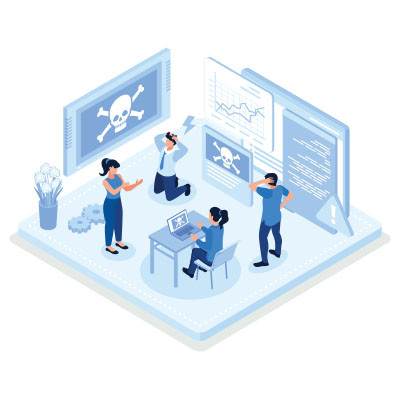Technology has ingrained itself into just about every facet of modern life, particularly in the business world where every competitive edge makes a difference. Many small and medium-sized businesses simply don’t have the staff on-hand to manage and maintain their technology solutions, instead opting to outsource this important responsibility to managed service providers (MSPs).
Apex Technology Blog
For any business to succeed, it needs to exhibit some degree of empathy toward its audience. Otherwise, the services and products they offer will be less likely to meet the priorities and needs that its targets are experiencing.
As a managed service provider, this is perhaps most true of us, as our services revolve around predicting the needs of our clientele and resolving them… ideally, before the client even realizes they have a need to fulfill.
For the IT administrator and the small business owner, it can be a bewildering experience when your company comes under siege from employee-induced cyberthreats; especially if you, like many other companies, have started prioritizing security training. Even if the threat is thwarted early and the effect on the business is negligible, it is important that you trust the people who have access to your organization’s digital resources. Let’s look at some of the reasons some of your staff take cybersecurity initiatives worse than others.
Businesses will often go into the process of self-improvement with unrealistic expectations for how much they can significantly improve their functionality. This simply is not true, and sometimes business owners need to realize that real change—the kind that yields real results—takes time. Thankfully, there are some actionable steps you can take to ensure that your business is moving in the right direction.
We have the pleasure of working with many businesses, some of whom take more advantage of our remote services than others. We wanted to take a few moments to discuss one of our more discreet client organizations and a challenge we helped them resolve. Hopefully, sharing this won’t land us on the naughty list.
The cloud has enabled managed IT service providers, or MSPs, to fill a uniquely shaped void in many companies’ business models. Working with a managed service provider can make up for all of the traditional challenges of technology maintenance and management while also affording you unique opportunities to reduce costs, minimize waste, and maximize productivity.
Compliance is a critical element of many businesses’ requirements, with pretty severe penalties as a consequence if the prescribed standards are not met. Even more importantly, most compliance requirements and regulations are put in place for the welfare of not only the business, but its clientele as well. This makes it critical to know which apply to your business, and how to meet them fully.
How does your business manage its IT? Do you have an in-house team, and how busy are they with all of the hustle and bustle of their everyday duties? Do they have time to address the many challenges and requests made of them? If not, then perhaps you should consider a different model for your IT management. Luckily, we have just the opportunity for you, and you won’t want to miss out on it.
Somehow, it’s December. Can you believe it?
2023 is practically upon us, and hopefully by now you’ve started to put some thought into how your business will maneuver through the next 12 months. It’s important to establish an IT plan and budget, so that your technology can actually be a value center as opposed to an expense.
Digital transformation is projected to make huge waves in the business environment, with an anticipated value of approximately $767 billion by the year 2026. It’s clear that businesses have lofty ambitions and expectations for their digital transformation initiatives, but there is a shadow that is cast on this number that holds many companies back: many of these initiatives fail, and fail hard. Why is this the case? We explore these reasons in this month’s newsletter.
Your business is your livelihood, so it only makes sense to invest in its protections so that your livelihood is secure. This will require a strategic approach. Let’s go over what your business needs to remain sufficiently secure, and what you should look for from each to get the best, most secure option.
Technology is one part of your business where you would rather take proactive measures than react to issues that pop up. After all, preventing some of the disasters and problems which surface could save you so much time and resources. Here are five of the best reasons why you should take a proactive approach to your business’ technology infrastructure.
Maintaining your business’ technology can be a lot to handle, particularly if you don’t have any IT staff members on hand to dedicate to its management. Managed services make this process a lot simpler, ensuring that (amongst other key benefits) your desktop solutions remain up-to-date and prepared for anything. Here are three basic tips to follow to ensure your desktops remain maintained.
It’s not often that something profoundly changes the landscape of business technology management as much as managed services has. When implemented correctly, managed IT services can completely replace the traditional methods of technology management within a company, and it all starts with changing not just your budgeting practices but also your maintenance practices.
Problems with your technology can often be spotted long before they become major time-consuming difficulties, but the catch with this statement is that you have to actively be looking for them in order to do so. If you want your business to remain profitable, you have to make sure that your technology is not wasting your business time or resources, and one way to do this is by actively monitoring your network for these issues.
How often do you find yourself in this situation? You are typing away on your computer pushing through your day-to-day tasks, scratching items off your to-do list, and communicating with your employees when suddenly, your computer freezes up. You’re then forced to perform a hard reset just to get your computer responsive again.
When you walk into most new businesses you’d be hard-pressed to think that IT has only been used in business for a few decades. Most businesses today use a variety of workstations (network endpoints) to handle scheduling, inventory, procurement, payroll, and a litany of other business functions. With that in mind, it stands to reason that keeping that IT working is the only way to efficiently run your business. We thought we’d take a look at how to keep your IT support costs low while keeping your technology managed properly.



























